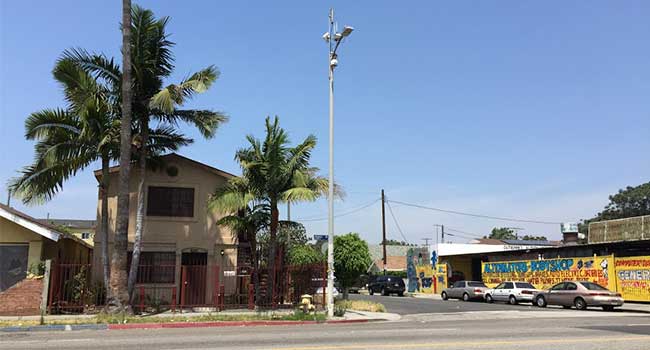
Securing the Backstreets of South L.A.
The South Los Angeles Industrial Tract (SLAIT) Business Improvement District is located within a "special economic incentive zone".
In September 2014, Tim Weir, President of Metro Video Systems, Inc. was contacted by Susan Levi, Director of SLAIT BID (South Los Angeles Industrial Tract - Business Improvement District) to support the existing IP Video Surveillance. Metro Video Systems provided support on the existing system but quickly recognized that this system was antiquated, parts were discontinued and an overhaul was essential. A meeting between Weir and Levi initiated the process.
Weir gathered his staff led by Jim Sage, Project Manager and Octavio Navarro, Engineer to diligently work on engineering and specifications for a complete IP Video Surveillance Enhancement for SLAIT BID.
Octavio Navarro explains that business owners in the Tract, through a management board, all contribute funds to cover costs of law enforcement response (localized within the SLAIT), tree trimming, garbage collection, and other specialized services for the tenants of the Tract. Enhanced video surveillance was called for, so the project was initiated to provide the Tract with a wireless CCTV surveillance network and replace old technology such as cameras and the legacy wireless solution. The area, Navarro reports, is in an industrial area that has been the home to family owned business passed through several generations. It is also adjacent to Watts, Downtown Los Angeles and South Central Los Angeles. This historical region of Los Angeles has a high crime rate and history of gang violence. The SLAIT Area in particular is a highly dynamic group of industries that are extremely active during the day and some during the night time. The Tract spans about 50 square blocks of industrial businesses, including pallet makers, food truck garages, food suppliers, furniture and clothing outlets, etc.
Technical & Logistical Challenges
After gaining a solid understanding of how Fluidmesh antennas work, the Metro Video Systems team created a design that could cover the area. The technical challenge was to overcome the many obstacles the Tract's previous system had to contend with, most having to do with line of sight issues and interference.
Jim Sage, Project Manager, looked for an alternative path for the antennas to carry the signal to the head end and broke the project into smaller increments to ensure successful results at each stage.
From a logistical perspective, Navarro says that they needed to come up with an infrastructure that could be easily duplicated and that would meet the budget restrictions. That infrastructure encompassed all the components that were required to install at a particular light pole: Camera, antenna, switches, UPSs, enclosures, cables, etc.
System Components
The SLAIT CCTV System comprises one Server and one client running the software. The two are connected via Cisco Switches to the Fluidmesh infrastructure which comprises tens of VOLO 1200 and MITO 3100. The FM1200 VOLO is a 2x2 MIMO-based Ethernet radio designed for mission-critical video, voice and data. VOLO is intuitive, easy to deploy and used to create point-to-point, point-to-multipoint, mesh and mobility networks with a real throughput of 150Mbps. There is a huge amount of SONY Full HD cameras capturing outdoor video in the area of Tract.
Why Wireless Mesh?
The management of the Tract wanted a reliable solution that didn't create a visual nuisance, offered enhanced performance and would be easy to maintain. The Fluidmesh wireless mesh solution delivered that. And, the system is scalable well into the future if SLAIT elects to add more cameras for surveillance purposes."The new system has far surpassed our expectations," says Levi. "The visibility and capabilities are a vast improvement from our previous system."
Benchmarks of the Project
There were many compelling improvements to the Tract's new system vs. the older one they upgraded. While the previous system consisted of more cameras, they were very low resolution, whereas the new Full HD cameras provide a complete enhancement of the views of the streets, businesses, alleys, etc. SLAIT management was stunned by the superior video quality and ability to control them. "They compared the views and quality of new vs. old and really were immediately impressed," Navarro notes. "They could do things they couldn't do before, like check license plates and faces in range of cameras that they couldn't previously see."
Consequently, SLAIT's Security staff can now see faces in real time and direct its guards to take care of incidents that were happening. "Unfortunately, there are many incidents that occur." Navarro explains. "Now entire incidents are being captured on camera. SLAIT management is extremely pleased to finally have the video coverage they need to meet all their requirements."
Case Study details:
Integrator: Metro Video System, Inc.
End User: South Los Angeles Industrial, Tract (SLAIT BID) Business Improvement District